Since childhood, everyone knows that garlic is an excellent preventive remedy for various diseases. Its benefits are countless. However, like other plants, garlic can be affected by pests and diseases.
In this article, we will take a detailed look at garlic diseases, as well as methods of control and prevention.
Table of contents
Garlic Diseases: Treatment and Prevention
Garlic is mainly affected by fungal diseases. There are also viral (yellow dwarfism) and bacterial (bacteriosis) infections.
The most common pests attacking garlic are the garlic mite and stem nematode.
Pink Root Rot
Pink root rot is a fungal disease (caused by Phoma terrestris) that spreads primarily through soil or infected planting material.
The optimal temperature for disease development is between +25°C and +30°C.
- Symptoms. Pink root rot affects the roots and outer scales, rarely killing the plant. Initially, the roots turn light pink, then red and purple. Eventually, they darken and die.
- Treatment. Fungicides such as Amistar can help combat pink root rot.
- Prevention. Follow crop rotation rules: avoid planting garlic in the same spot where other alliums grew for at least 4 years. Treat planting material with fungicidal dressings before sowing.
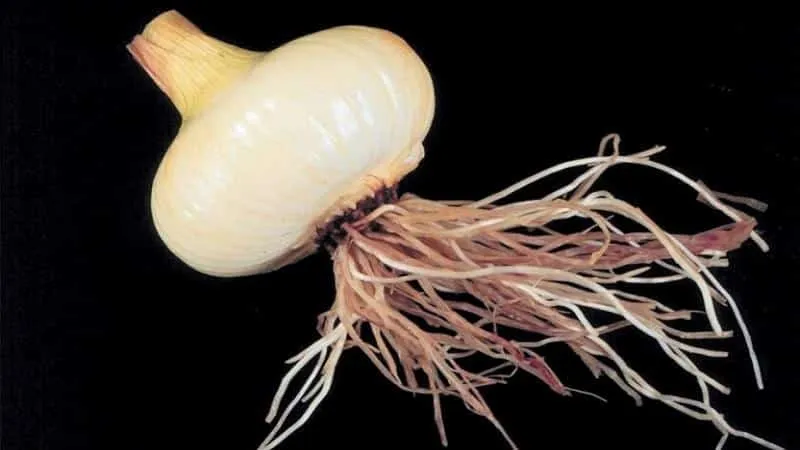
White Rot
White rot, or sclerotinia, is caused by the fungus Sclerotium cepivorum. Infection occurs through soil at temperatures between +10°C and +24°C. It is one of the most dangerous diseases for alliums.
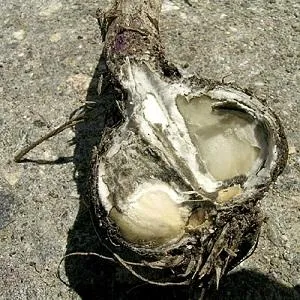 Symptoms. White rot destroys the plant's roots, followed by bulb decay. The fungus appears as white mycelium on the roots and bulb. External signs include yellowing leaves, starting from the tips.
Symptoms. White rot destroys the plant's roots, followed by bulb decay. The fungus appears as white mycelium on the roots and bulb. External signs include yellowing leaves, starting from the tips.
Treatment. At the first signs of infection, use fungicides such as Signum, Switch, or Uniform.
Prevention. Treat planting material with Maxim XL to protect against white rot. Use only clean, healthy planting material, tools, and containers. Follow proper crop rotation.
The pathogen (spores) can survive in dry conditions for years on boxes, tools, and other surfaces. Disinfect all equipment after contact with infected plants.
Fusarium
Fusarium basal rot is caused by fungi of the Fusarium genus. Infection occurs through bulbs, soil, and plant debris.
The disease spreads best in hot (28–32°C) and humid conditions.
- Symptoms. Leaves yellow and brown from the tips downward. A pink coating may appear on the pseudostem. Roots and bulbs turn pink and rot. White fungal growth develops inside the bulb.
- Treatment. The same fungicides as for white rot: Signum, Switch, or Uniform.
- Prevention. Use fungicidal dressings like Maxim XL. Remove and burn infected plants along with surrounding soil. Disinfect tools and follow crop rotation.
Important! The fungus produces toxins that can cause severe poisoning.
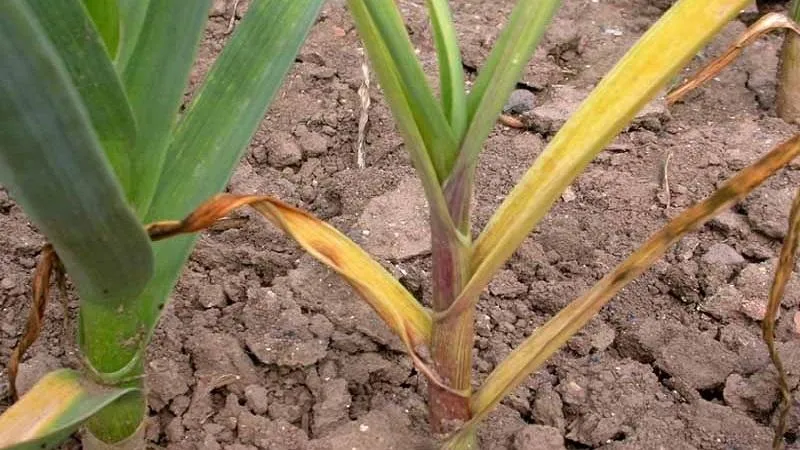
Neck Rot
Neck rot is caused by Botrytis fungi. It primarily affects garlic during storage. Infection occurs through soil or infected planting material. The ideal temperature for disease development is 15–20°C.
Symptoms. The disease appears 1–2 months after harvest. The neck softens, becomes slimy, and develops a gray fuzzy mold.
Gray-brown mold spreads across the cloves. Eventually, the entire bulb rots within 1–2 months, contaminating healthy garlic.
Treatment. Since symptoms are invisible during growth, timely treatment is difficult. However, fungicides like Signum, Switch, Uniform, Ridomil Gold, or Acrobat can be effective during the growing season.
Prevention. Treat bulbs with Maxim XL, follow crop rotation, apply balanced fertilization (especially phosphorus), harvest on time, and dry bulbs thoroughly before storage.
Store only healthy bulbs at 0 to -2°C with humidity below 70%.
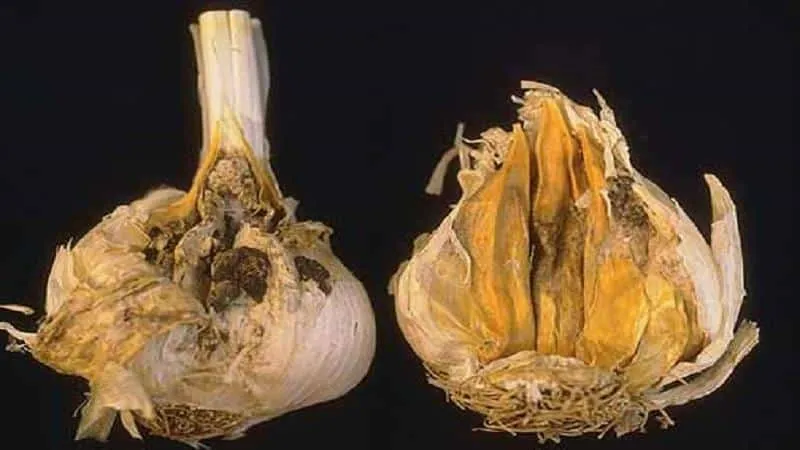
Penicillium Rot (Blue Mold)
Penicillium rot is caused by fungi of the Penicillium genus. It spreads mainly through infected planting material.
During storage, spores transfer from infected to healthy bulbs.
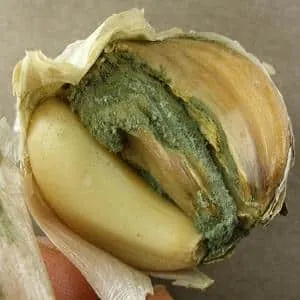 High temperature and humidity in storage accelerate the disease.
High temperature and humidity in storage accelerate the disease.
- Symptoms. Yellowing leaves, stunted growth, and blue-green mold at the base. Bulbs develop white mold that turns green. Cloves become soft and separate.
- Treatment. Use fungicides like Amistar, Shirlan, or Bumper Super.
- Prevention. Select healthy planting material and treat it with antifungal agents. Follow crop rotation and destroy (do not compost) infected bulbs.
Dry harvested garlic for 3–4 weeks before storage. Store at ≤10°C and ≤60% humidity.
Aspergillus Rot (Black Mold)
Black mold is caused by Aspergillus fungi. It spreads via soil, windborne spores, and infected planting material. Thrives in warm, humid conditions.
Symptoms. Black powdery mold around the neck, spreading across the bulb.
Treatment. The same fungicides as for penicillium rot: Amistar, Shirlan, or Bumper Super.
Prevention. Treat planting material, store at low temperatures (+1–+12°C, ≤65% humidity), and dry bulbs thoroughly after harvest.
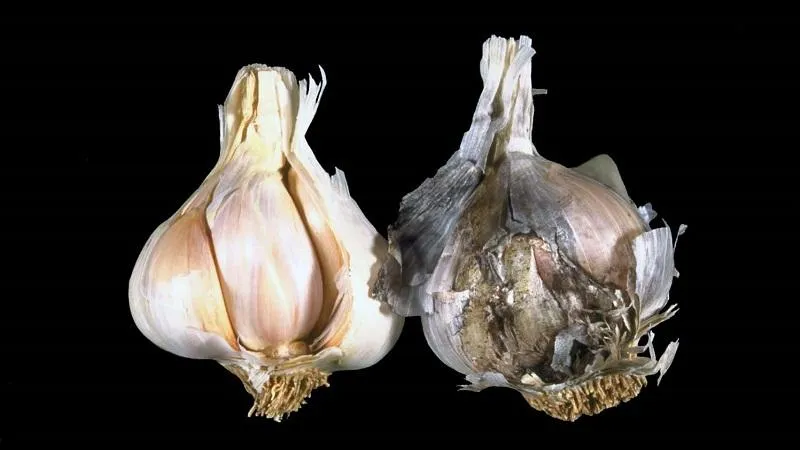
Downy Mildew
Downy mildew, caused by Peronospora destructor, can devastate garlic crops. It thrives in cool, damp weather.
Transmitted via soil, infected planting material, and gardening tools.
- Symptoms. Yellow spots on shoots, later covered in gray or purple spores. Leaves curl and wither.
- Treatment. Use fungicides like Amistar, Areva Gold, or Ridomil Gold.
- Prevention. Use healthy planting material, avoid overhead watering, or water early in the day.
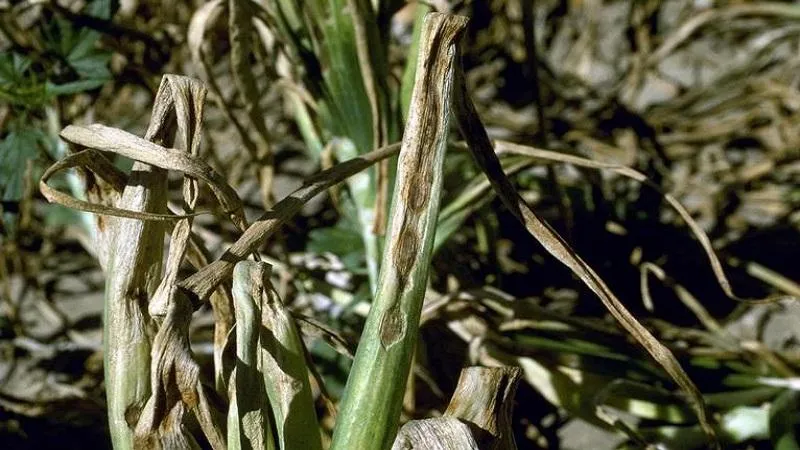
Rust
Garlic rust, caused by Puccinia alli, slows plant growth. Favors cool, damp weather.
Symptoms. Rust-colored spots on leaves, later turning black.
Treatment. Remove infected leaves promptly. Effective fungicides include Amistar, Nativo, and Signum.
Prevention. Crop rotation, sunlight exposure, and avoiding evening watering.
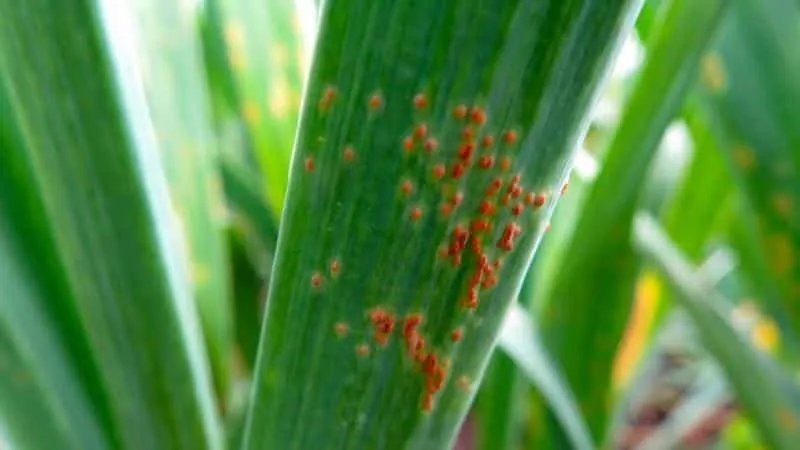
Yellow Dwarfism
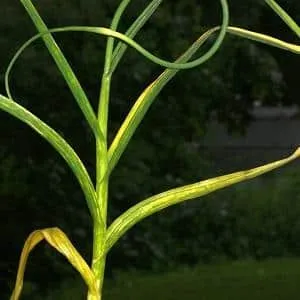 Yellow dwarfism is a viral disease spread by pests (aphids, garlic mites, nematodes) and infected planting material.
Yellow dwarfism is a viral disease spread by pests (aphids, garlic mites, nematodes) and infected planting material.
- Symptoms. Yellow streaks on leaves, bending at the base, stunted growth.
- Treatment. No chemical treatment exists—focus on prevention.
- Prevention. Use virus-free planting material, control pest vectors, and destroy (do not compost) infected plants.
Bacterial Soft Rot
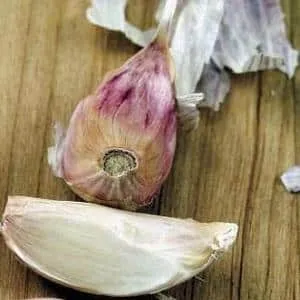 Caused by Erwinia carotovora, this disease spreads via insects, rain, or irrigation water. Thrives in warm, wet conditions.
Caused by Erwinia carotovora, this disease spreads via insects, rain, or irrigation water. Thrives in warm, wet conditions.
Symptoms. Soft, waterlogged cloves; foul-smelling liquid when pressed.
Treatment. Fungicides like Cuprozin or Curzate R.
Prevention. Dry bulbs before storage, store at low temperatures (≤65% humidity), avoid overhead watering, and use copper-based bactericides.
Stem Nematode
Nematodes are microscopic worms that attack all parts of garlic except roots. They feed on plant sap, eventually killing it.
- Symptoms. Pale streaks on leaves, twisted and withered foliage, rotten odor.
- Treatment. Use nematicides like Nemathorin or Vertimec.
- Prevention. Rotate crops every 4–5 years. Soak planting material in hot water (40°C for 10–15 min, 45°C for 5–6 min, or 55°C for 2–4 min). Disinfect tools.
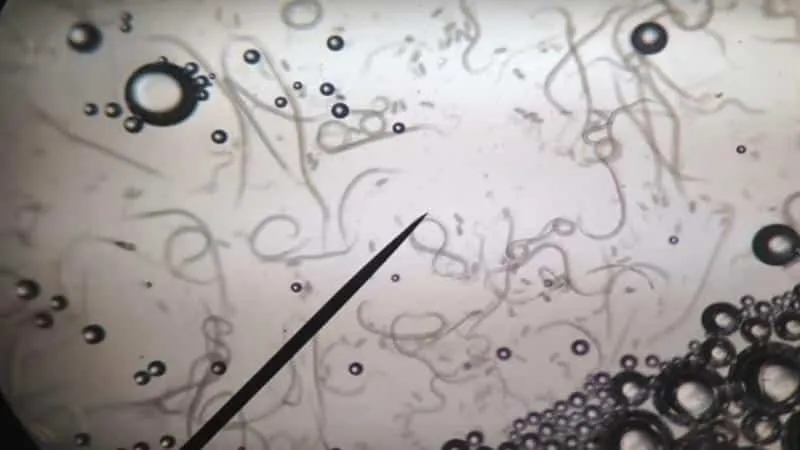
Garlic Mite
The four-legged garlic mite infests garlic during growth and storage. Spreads via soil, wind, and infected planting material.
Mites (≤0.25 mm) lay eggs on plant tissue, which overwinter on harvested bulbs.
Symptoms. Light brown/yellow spots on leaves and cloves, distorted growth, white powdery residue.
Treatment. Apply acaricides like Vertimec or Bi-58.
Prevention. Deep plowing, crop rotation, and avoiding acidic soils. Treat cloves with acaricides before planting.
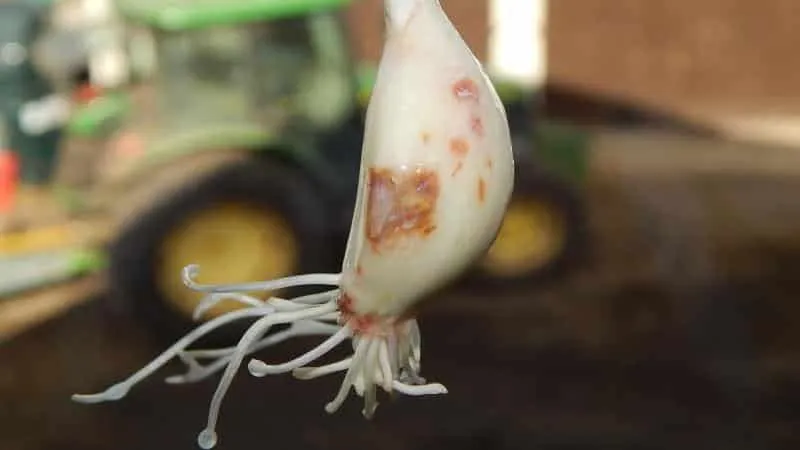
General Prevention and Protection Tips
The key rules are 4–5-year crop rotation and using only healthy planting material. Never compost infected plants—burn them.
Many garlic diseases develop during storage. Follow proper harvesting, drying, and storage protocols.
Pre-treat planting material with hot water or fungicides. Disinfect tools, shoes, and clothing that contact infected plants.
At the first signs of disease or pests, use targeted fungicides, insecticides, or acaricides.
Important! Use chemicals carefully—only apply treatments designed for specific diseases. Follow instructions precisely.
Conclusion
Garlic is a must-grow crop for every gardener. Simple preventive measures can protect it from diseases and pests.
If infections occur, don’t worry—most diseases are treatable if detected early.







